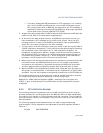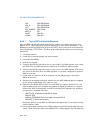
8-32 Vol. 3
MULTIPLE-PROCESSOR MANAGEMENT
MOV EAX, 000C46XXH; Load ICR encoding from broadcast SIPI IP
; to all APs into EAX where xx is the vector computed in step 8.
16. Waits for the timer interrupt.
17. Reads and evaluates the COUNT variable and establishes a processor count.
18. If necessary, reconfigures the APIC and continues with the remaining system
diagnostics as appropriate.
8.4.4.2 Typical AP Initialization Sequence
When an AP receives the SIPI, it begins executing BIOS AP initialization code at the
vector encoded in the SIPI. The AP initialization code typically performs the following
operations:
1. Waits on the BIOS initialization Lock Semaphore. When control of the semaphore
is attained, initialization continues.
2. Loads the microcode update into the processor.
3. Initializes the MTRRs (using the same mapping that was used for the BSP).
4. Enables the cache.
5. Executes the CPUID instruction with a value of 0H in the EAX register, then reads
the EBX, ECX, and EDX registers to determine if the AP is “GenuineIntel.”
6. Executes the CPUID instruction with a value of 1H in the EAX register, then saves
the values in the EAX, ECX, and EDX registers in a system configuration space in
RAM for use later.
7. Switches to protected mode and insures that the APIC address space is mapped
to the strong uncacheable (UC) memory type.
8. Determines the AP’s APIC ID from the local APIC ID register, and adds it to the MP
and ACPI tables and optionally to the system configuration space in RAM.
9. Initializes and configures the local APIC by setting bit 8 in the SVR register and
setting up the LVT3 (error LVT) for error handling (as described in steps 9 and 10
in
Section 8.4.4.1, “Typical BSP Initialization Sequence”).
10. Configures the APs SMI execution environment. (Each AP and the BSP must have
a different SMBASE address.)
11. Increments the COUNT variable by 1.
12. Releases the semaphore.
13. Executes the CLI and HLT instructions.
14. Waits for an INIT IPI.


















